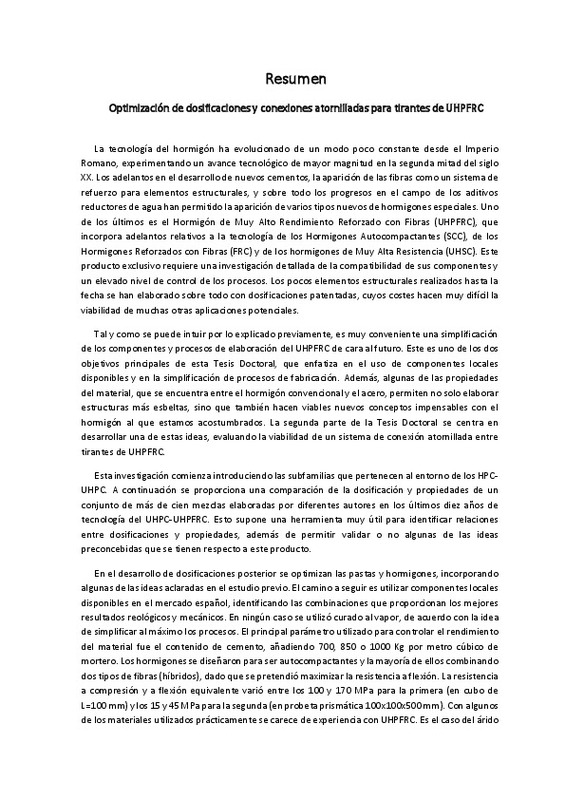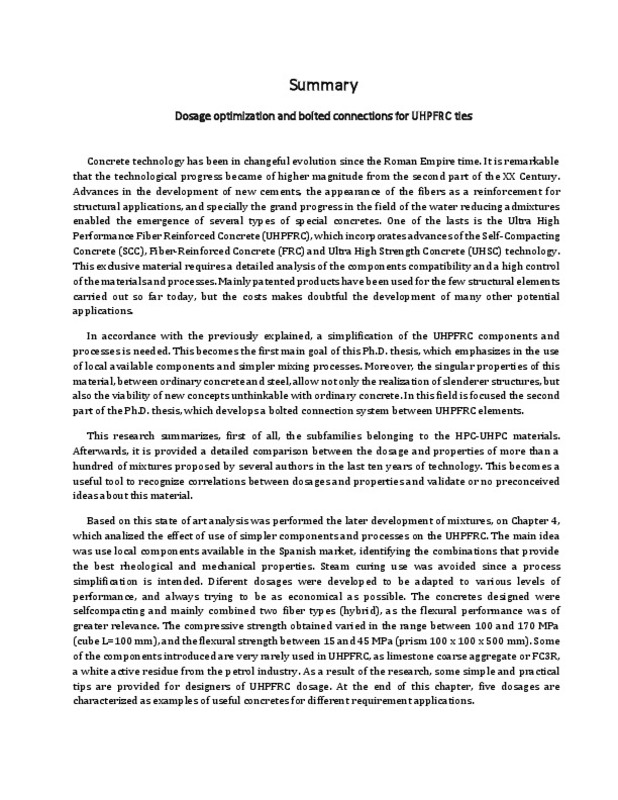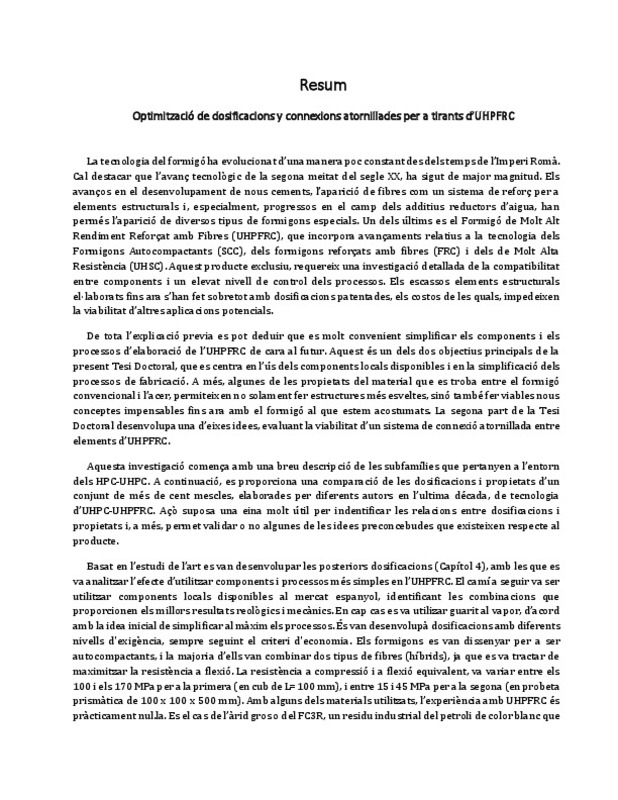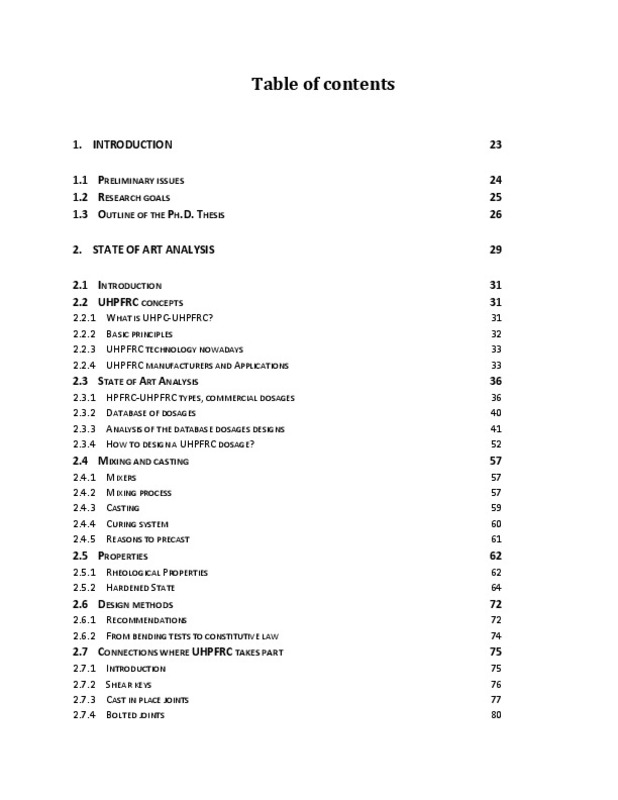- RiuNet repositorio UPV
- :
- Investigación
- :
- Tesis doctorales
- :
- Ver ítem
JavaScript is disabled for your browser. Some features of this site may not work without it.
Buscar en RiuNet
Listar
Mi cuenta
Estadísticas
Ayuda RiuNet
Admin. UPV
Dosage optimization and bolted connections for UHPFRC ties
Mostrar el registro sencillo del ítem
Ficheros en el ítem
| dc.contributor.advisor | Serna Ros, Pedro
|
es_ES |
| dc.contributor.author | Camacho Torregrosa, Esteban Efraím
|
es_ES |
| dc.date.accessioned | 2014-01-07T07:47:43Z | |
| dc.date.available | 2014-01-07T07:47:43Z | |
| dc.date.created | 2013-12-20T10:00:22Z | es_ES |
| dc.date.issued | 2014-01-07T07:47:39Z | es_ES |
| dc.identifier.uri | http://hdl.handle.net/10251/34790 | |
| dc.description.abstract | Concrete technology has been in changeful evolution since the Roman Empire time. It is remarkable that the technological progress became of higher magnitude from the second part of the XX Century. Advances in the development of new cements, the appearance of the fibers as a reinforcement for structural applications, and specially the grand progress in the field of the water reducing admixtures enabled the emergence of several types of special concretes. One of the lasts is the Ultra High Performance Fiber Reinforced Concrete (UHPFRC), which incorporates advances of the Self-Compacting Concrete (SCC), Fiber-Reinforced Concrete (FRC) and Ultra High Strength Concrete (UHSC) technology. This exclusive material requires a detailed analysis of the components compatibility and a high control of the materials and processes. Mainly patented products have been used for the few structural elements carried out so far today, but the costs makes doubtful the development of many other potential applications. In accordance with the previously explained, a simplification of the UHPFRC components and processes is needed. This becomes the first main goal of this Ph.D. thesis, which emphasizes in the use of local available components and simpler mixing processes. Moreover, the singular properties of this material, between ordinary concrete and steel, allow not only the realization of slenderer structures, but also the viability of new concepts unthinkable with ordinary concrete. In this field is focused the second part of the Ph.D. thesis, which develops a bolted connection system between UHPFRC elements. This research summarizes, first of all, the subfamilies belonging to the HPC-UHPC materials. Afterwards, it is provided a detailed comparison between the dosage and properties of more than a hundred of mixtures proposed by several authors in the last ten years of technology. This becomes a useful tool to recognize correlations between dosages and properties and validate or no preconceived ideas about this material. Based on this state of art analysis was performed the later development of mixtures, on Chapter 4, which analized the effect of use of simpler components and processes on the UHPFRC. The main idea was use local components available in the Spanish market, identifying the combinations that provide the best rheological and mechanical properties. Steam curing use was avoided since a process simplification is intended. Diferent dosages were developed to be adapted to various levels of performance, and always trying to be as economical as possible. The concretes designed were selfcompacting and mainly combined two fiber types (hybrid), as the flexural performance was of greater relevance. The compressive strength obtained varied in the range between 100 and 170 MPa (cube L=100 mm), and the flexural strength between 15 and 45 MPa (prism 100 x 100 x 500 mm). Some of the components introduced are very rarely used in UHPFRC, as limestone coarse aggregate or FC3R, a white active residue from the petrol industry. As a result of the research, some simple and practical tips are provided for designers of UHPFRC dosage. At the end of this chapter, five dosages are characterized as examples of useful concretes for different requirement applications. In a second part, the idea of a bolted joint connection between UHPFRC elements was proposed. The connection system would be especially useful for struts and ties elements, as truss structures. The possible UHPFRC failure modes were introduced and two different types of tests were designed and performed to evaluate the joint capacity. The geometry of the UHPFRC elements was modified in order to correlate it with the failure mode and maximum load reached. Also a linear finite element analysis was performed to analyze the UHPFRC elements connection. This supported the results of the experimental tests to deduce formulations that predict the maximum load for each failure mode. Finally, a real size truss structure was assembled with bolted joints and tested to verify the good structural behavior of these connections. To conclude, some applications designed and developed at the Universitat Politècnica de València with the methods and knowledge acquired on UHPFRC are abstracted. In many of them the material was mixed and poured in a traditional precast concrete company, providing adequate rheological and mechanical results. This showed the viability of simpler UHPFRC technology enabling some of the first applications in Spain with this material. | en_EN |
| dc.language | Inglés | es_ES |
| dc.publisher | Universitat Politècnica de València | es_ES |
| dc.rights | Reserva de todos los derechos | es_ES |
| dc.source | Riunet | es_ES |
| dc.subject | Ultra High Performance Fiber Reinforced Concrete | es_ES |
| dc.subject | Dosage optimization | es_ES |
| dc.subject | Compatibility | es_ES |
| dc.subject | Precast | es_ES |
| dc.subject | Bolted connection | es_ES |
| dc.subject | Joint | es_ES |
| dc.subject | Applications | es_ES |
| dc.subject.classification | INGENIERIA DE LA CONSTRUCCION | es_ES |
| dc.title | Dosage optimization and bolted connections for UHPFRC ties | |
| dc.type | Tesis doctoral | es_ES |
| dc.identifier.doi | 10.4995/Thesis/10251/34790 | es_ES |
| dc.rights.accessRights | Abierto | es_ES |
| dc.contributor.affiliation | Universitat Politècnica de València. Departamento de Ingeniería de la Construcción y de Proyectos de Ingeniería Civil - Departament d'Enginyeria de la Construcció i de Projectes d'Enginyeria Civil | es_ES |
| dc.description.bibliographicCitation | Camacho Torregrosa, EE. (2013). Dosage optimization and bolted connections for UHPFRC ties [Tesis doctoral]. Universitat Politècnica de València. https://doi.org/10.4995/Thesis/10251/34790 | es_ES |
| dc.description.accrualMethod | TESIS | es_ES |
| dc.type.version | info:eu-repo/semantics/acceptedVersion | es_ES |
| dc.relation.tesis | 7320 | es_ES |
Este ítem aparece en la(s) siguiente(s) colección(ones)
-
Tesis doctorales [5389]












